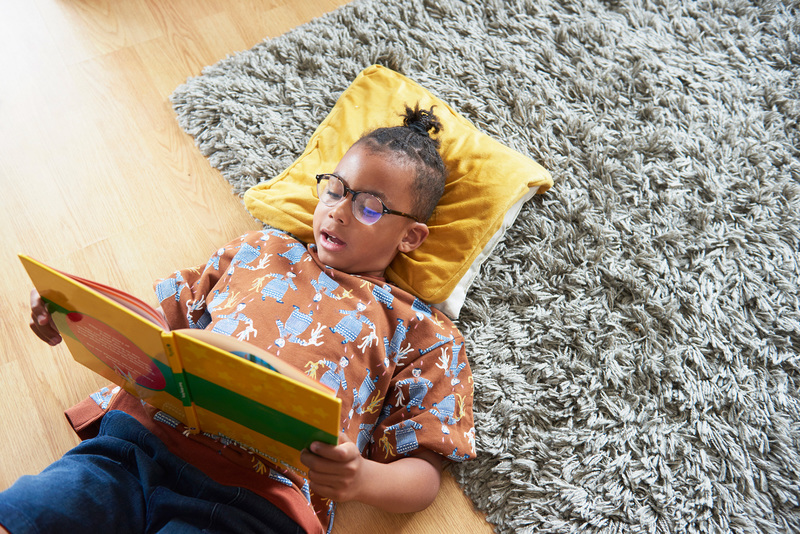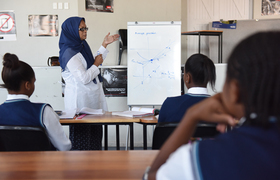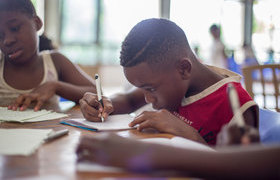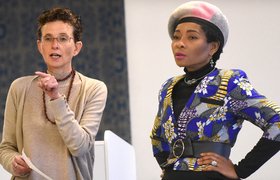International Literacy Day: Transform SA’s literacy learning spaces
08 September 2022 | Story Niémah Davids. Photo Getty Images. Read time 9 min.
Transforming literacy learning spaces at primary school level is critical for South Africa, and it requires incorporating storytelling, games, drama, music and art into the curricula. This novel technique encourages reflective, interactive learning spaces and is guaranteed to boost literacy levels among children, said the University of Cape Town’s (UCT) Dr Xolisa Guzula.
Dr Guzula is an early literacy expert in UCT’s School of Education, and she spoke to UCT News on International Literacy Day. The UNESCO-led day of observance is celebrated annually on 8 September and the theme for 2022 is: “Transforming literacy learning spaces”. According to research by the Progress in International Reading Literacy Study (PIRLS) – an assessment and research project designed to measure reading achievement at Grade 4 level, 78% of Grade 4 learners in South Africa struggle to read fluently or can’t read for meaning. This statistic paints a bleak picture for a large number of learners in the country, especially non-English first language speakers.
“I must point out that these research studies and assessments only test reading levels and not literacy as a whole. Literacy includes more than just reading. It includes writing, critical literacies and multi-modal literacies as well,” Guzula said.
During this interview, she highlighted the need for transformed literacy spaces to boost literacy levels in the country. She also touched on work that has already been done in this space and the subsequent benefits for the learner.
Niémah Davids (ND): As a researcher in this area, what are some of the biggest challenges you’ve observed over the years regarding the methods used to teach children how to read?
“Teachers are required to teach reading simply using direct instruction in letter–sound relationships.”
Xolisa Guzula (XG): We’ve long noticed that teachers are required to teach reading simply using direct instruction in letter–sound relationships. During this process children learn to sound out letters of the alphabet, build words by breaking these down into smaller units and read them repeatedly to gain fluency and accuracy. This is an age-old method and simply isn’t sufficient on its own to teach children [how] to read. So, we decided to explore an alternative aspect to reading; one that appeals to their emotions.
We decided to focus on reading for enjoyment, which requires that adults either tell children stories or read to them engagingly. While doing so we encourage them to incorporate drama and other forms of art into the storytelling process to create excitement around the concept of reading.
ND: Tell us about the reading clubs you have established in collaboration with colleagues to encourage a reading culture.
XG: A group of us, including the late Dr Neville Alexander, were involved with the Project for the Study of Alternative Education in South Africa (PSAESA) – a non-governmental organisation focused on multilingual education and language and literacy development. Through this work we met up with Zisukhanyo Youth Empowerment in Langa, and together we decided to start the Vulindlela Reading Club. The club aimed to build a culture of reading among children in Langa. We made both English and isiXhosa books available, shared our love for reading with them and encouraged them to immerse themselves in literature. This enabled participants to engage with reading and writing in meaningful ways. We found that children attended club sessions because they really wanted to read and were not forced to read when they were not ready. By joining the club, they were involved in exciting activities that related to reading and literacy, and they loved it.
After the success of the Vulindlela Reading Club, we established the Nal’ibali National Reading for Enjoyment Initiative. This initiative essentially took the work of the Vulindlela Reading Club to scale across the country – establishing reading clubs, creating newspaper supplements with stories for parents to share with their children at home, training reading club facilitators, developing new stories and making them available in South Africa’s 11 official languages.
ND: Your work didn’t end with the Vulindlela Reading Club and the Nal’ibali National Reading for Enjoyment Initiative, did it?
XG: I’ve always believed that we need to change the way we teach to appeal to our children. And it’s been at the heart of my work for years. After successfully developing the Nal’ibali Reading for Enjoyment Initiative, I left UCT and joined the Nelson Mandela Institute for Education and Rural Development. While there, I worked on the Phemba Mfundi Project to develop and strengthen reading and writing skills among the youth. Children who were part of the project wrote poetry, stories, personal narratives and autobiographies, and these pieces of writing were later published in what we called the Journal of Learner Writing. Once these journals were printed, they formed part of the list of reading material at participants’ schools.
“We created pedagogical third spaces that combined children’s multilingualism and multimodal literacies to demonstrate the learning benefits that come with working this way.”
When I returned to UCT to complete my PhD, I started the Stars of Today Literacy Club to teach language and literacy to bilingual children. We created pedagogical third spaces that combined children’s multilingualism and multimodal literacies to demonstrate the learning benefits that come with working this way.
Later, I also co-founded the Bua-lit Language and Literacy Collective in collaboration with a group of colleagues in UCT’s School of Education and the Department of Historical Studies, as well as a few from outside of the university. Our goal is to collectively fight for social justice in language and literacy. Bua-lit advocates for bi-multilingual education. Recently we also started assisting schools with drafting inclusive language policies, and training their school governing body members, teachers and parents on these policies and how to implement multilingual pedagogies in the classroom. We also create bi-multilingual materials for language and literacy, as well as for science, and showcase the work done by others to advance bi-multilingual education.
ND: What’s your goal with this work?
XG: My aim is to enrich children’s language and literacy learning experiences and to highlight that those non-English first language speakers don’t need simplistic approaches to learning if they want to succeed at school and at institutions of higher learning. Children who learn an indigenous African language as well as English cannot be pulled into learning English-only or mother-tongue-only education in order to succeed. What they need is the best of both languages to flourish.
ND: Why is it so important to transform literacy learning spaces and what should they look like?
XG: This is absolutely necessary to build and develop a healthy literacy culture among children. One way of doing this is by integrating reading and writing with storytelling, art, drama, music and games. If children can relate to the content, they will develop that love for reading. So, transformation is definitely needed in this regard.
In education, we need to realise that children learn using both formal and informal methods, which includes learning through play. Children also learn new skills by building on existing knowledges. We need to stop the divide between oral and written language because these are more interconnected than we care to admit. We also need to teach writing because if we don’t, we’ll start to see the effects at institutions of higher learning. If we don’t teach multiple modes of communication, we’ll struggle to grow and develop creative 21st-century professionals.
ND: Once we’ve successfully transformed literacy learning spaces in the country, how do we sustain the process?
“It takes a while to process learning into quality, meaningful experiences, and we are getting there.”
XG: So much work has already been done by a few of the organisations in the country and this is very encouraging, but it remains an ongoing process. We can sustain this work if we don’t force these organisations to scale their work too quickly. We need to allow them the time to develop knowledge capacities and skills among those who they work with (teachers and children), before expanding to new spaces. Moving too quickly dilutes the quality of the work and makes it more about numbers and less about fully focusing on the work itself. Literacy learning is not like an injection; there’s no quick fix. It takes a while to process learning into quality, meaningful experiences, and we are getting there.
 This work is licensed under a Creative Commons Attribution-NoDerivatives 4.0 International License.
This work is licensed under a Creative Commons Attribution-NoDerivatives 4.0 International License.
Please view the republishing articles page for more information.










